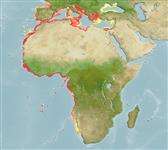Common names from other countries
Lớp phụ Cá sụn (cá mập và cá đuối) (sharks and rays) >
Squatiniformes (Angel sharks) >
Squatinidae (Angel sharks)
Etymology: Squatina: Latin for skate, which angel sharks superficially resemble, presumably tautonymous with Squalus squatina Linnaeus 1758 (no species mentioned). (See ETYFish); oculata: Latin for eyed or having eyes, referring to the symmetrical ocelli seen on some specimens. (See ETYFish).
More on author: Bonaparte.
Environment: milieu / climate zone / depth range / distribution range
Sinh thái học
Biển gần đáy; Mức độ sâu 5 - 500 m (Ref. 10719), usually 50 - 100 m (Ref. 247). Subtropical; 47°N - 29°S, 17°W - 37°E
Eastern Atlantic: Mediterranean and Morocco to Angola.
Bộ gần gũi / Khối lượng (Trọng lượng) / Age
Maturity: Lm ? range ? - ? cm
Max length : 160 cm TL con đực/không giới tính; (Ref. 247); common length : 120 cm TL con đực/không giới tính; (Ref. )
Short description
Khóa để định loại | Hình thái học | Sinh trắc học
Các tia vây lưng cứng (tổng cộng) : 0. An angelshark with large thorns on snout and above eyes but not on midback, weakly bifurcated nasal barbels and weakly fringed anterior nasal flaps, the first dorsal-fin origin usually well behind the rear tips of pelvic fin, and prominent white spots on body (Ref. 247)
Found on sand and mud bottom (Ref. 26999) of continental shelves and upper slopes (Ref. 247). Mostly between 50 and 100 m but deeper in the tropics (Ref. 247). Feeds on small fishes (Ref. 247). Ovoviviparous (Ref. 50449). Utilized fresh and dried salted for human consumption; liver oil and hide also used (Ref. 247).
Life cycle and mating behavior
Maturities | Sự tái sinh sản | Spawnings | Egg(s) | Fecundities | Ấu trùng
Ovoviviparous, embryos feed solely on yolk (Ref. 50449). Size at birth about 24 to 27 cm TL (Ref. 247).
Compagno, L.J.V., 1984. FAO Species Catalogue. Vol. 4. Sharks of the world. An annotated and illustrated catalogue of shark species known to date. Part 1 - Hexanchiformes to Lamniformes. FAO Fish. Synop. 125(4/1):1-249. Rome, FAO. (Ref. 247)
IUCN Red List Status (Ref. 130435)
CITES (Ref. 128078)
Not Evaluated
Threat to humans
Traumatogenic
Human uses
Các nghề cá: buôn bán nhỏ
Các công cụ
Special reports
Download XML
Các nguồn internet
Estimates based on models
Preferred temperature (Ref.
115969): 13 - 19.3, mean 15.3 (based on 133 cells).
Phylogenetic diversity index (Ref.
82804): PD
50 = 0.5000 [Uniqueness, from 0.5 = low to 2.0 = high].
Bayesian length-weight: a=0.00550 (0.00303 - 0.00997), b=3.06 (2.90 - 3.22), in cm Total Length, based on LWR estimates for this species & Genus-body shape (Ref.
93245).
Mức dinh dưỡng (Ref.
69278): 4.0 ±0.5 se; based on diet studies.
Thích nghi nhanh (Ref.
120179): thấp, thời gian nhân đôi của chủng quần tối thiểu là 4.5 - 14 năm (Fec assumed to be <100).
Fishing Vulnerability (Ref.
59153): Very high vulnerability (90 of 100).
